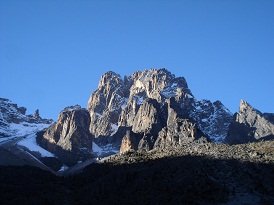
Mt Kilimanjaro Climbing
Day 1: Mandara Hut
Pick up early morning from a hotel in Moshi and drive to Marangu gate for registration and begin climbing through the rain forest to Mandara hut which is at 2700 meters above sea level. From its low rim you can see above the trees and should be able to see the main summit, Mt Kilimanjaro Climbing although in the afternoon it will almost certainly be cloud-capped. Dinner and overnight at Mandara hut.
12kms – 5 Hours Hiking Time
Day 2: Horombo Hut
An early breakfast followed by an ascend through the moorland and Maundi crater to Horombo hut which is at 3720 meters above sea level. Once you reach Horombo it is noticeably colder and you will need to have a fleece jacket or sweater with you. At this point you begin to feel the effects of altitude Mt Kilimanjaro Climbing . Dinner and overnight at Horombo hut.
15kms – 6 Hours Hiking Time
Day 3: Horombo Hut (Acclimatization Day)
The day is spent acclimitizing, hike towards Mawenzi hut, passing the Zebra Rocks on the way (about 3 hours up and 1.5 hours down), is strongly recommended. This hike will further assist with the process of acclimatisation. Remember to drink enough water and move slowly. Retire to bed early and get a last good night’s rest Mt Kilimanjaro Climbing. All meals and overnight Horombo hut.
Day 4: Kibo Hut Mt Kilimanjaro Climbing
Take breakfast and continue with the climb through the Alpine forest up to the “Last Water Point” where you should fill your bottles. The peak is visible as you head to Kibo hut which is at 4703 meters above sea level. You might experience headaches at this altitude and the night is also very cold. Dinner and overnight at kibo hut.
15kms – 6 Hours Hiking Time
Day 5: Summit – Horombo Hut
Wake up at 0000hrs and have some biscuits and tea. Begin the ascend to Uhuru peak which is at 5895 meters above sea level. The first section of the On the Summit. trail consists of a rocky path to the Hans Meyer Cave (5150m), also a good resting spot. The path then zigzags up to Gillman’s point (5 681m), which is located on the crater rim. This section is very steep with a lot of stone scree, Mt Kilimanjaro Climbing requiring a great physical and mental effort. Probably the most demanding section of the entire route. From Gillmans Point you will normally encounter snow all the way up to Uhuru peak (5895m), the highest point in Africa. After a photo session descend to kibo hut (3 hours) and after a short rest descend further to Horombo hut (3 hours) for dinner and overnight.
27kms – 14 Hours Hiking Time
Day 6: Moshi
After breakfast descend to Marangu gate via Mandara hut where you will sing out and be awarded with Summit certificate. Those climbers who reached Gillman’s Point (5685m) are issued with green certificates and those who reached Uhuru Peak (5895m), receive gold certificates. Transfer to moshi and check in to your hotel. A hot shower and rest is most rewarding after conquring Kilimanjaro.
12kms – 7 Hours Hiking Time
End of services
Price Includes:
- Camping Equipment
- Transport to and from the base of the mountain
- Fullboard Accommodation on the mountain
- Park Fees
- services of an english speaking guide, porters and a cook
- Rescue fee in case of an emergency
- H.F Radio Communication
Price Excludes:
- Hiking Equipments
- International air transportation to and from Nairobi
- Expenses of personal nature such as visas, travel/baggage insurance,laundry, beverages, tips etc
Mount Kilimanjaro is the highest mountain in Africa standing at 5,895 meters above sea level. The Mountain has been nick named “The roof of Africa”. It has three major peaks namely Kibo 5,895 m (19,341 ft); Mawenzi 5,149 m (16,893 ft); and Shira 3,962 m (13,000 ft). Uhuru Peak is the highest summit on Kibo’s crater rim. Kilimanjaro is a large stratovolcano. Two of its three peaks, Mawenzi and Shira, are extinct while Kibo is dormant and could erupt again. Mount Kilimanjaro is the highest free standing mountain in the world.
There are seven official trekking routes by which you can use to hike Mount Kilimanjaro namely Lemosho, Machame, Marangu, Mweka, Rongai, Shira, and Umbwe. Of all the routes, Machame is considered the most scenic and can be climbed in six or seven days. The Rongai is the easiest and least scenic of all camping routes. The Marangu is also relatively easy, but this route tends to be very busy, the ascent and descent routes are the same, and accommodation is in shared huts with all other climbers.
Required Hiking Equipments
- Sleeping Bag 15°C [4 seasons]
- Rain Trouser
- Rain Jacket [Poncho]
- Balaclava [Hat Woolen]
- Warm Clothes down jacket
- Thermal underwear
- Fleece Jacket
- Hiking Boots
- Gloves
- Walking Sticks
- Head Torch
- Sunglases
- Ruck Suck 65L [Carried by porters]
- Day Pack 35 [For your personal effects]
NB:// – Mosquito nets are not required
– You only require bottled water on the 1st day. The rest of the days we usually boil or purify the water with purifing tablets and you just re fill your drinking bottles.
– Proper equipments are vital to safe and enjoyable trek.